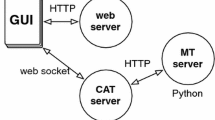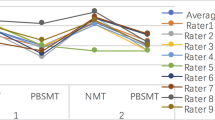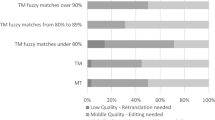Abstract
The advantages of neural machine translation (NMT) have been extensively validated for offline translation of several language pairs for different domains of spoken and written language. However, research on interactive learning of NMT by adaptation to human post-edits has so far been confined to simulation experiments. We present the first user study on online adaptation of NMT to user post-edits in the domain of patent translation. Our study involves 29 human subjects (translation students) whose post-editing effort and translation quality were measured on about 4500 interactions of a human post-editor and an NMT system integrating an online adaptive learning algorithm. Our experimental results show a significant reduction in human post-editing effort due to online adaptation in NMT according to several evaluation metrics, including hTER, hBLEU, and KSMR. Furthermore, we found significant improvements in BLEU/TER between NMT outputs and professional translations in granted patents, providing further evidence for the advantages of online adaptive NMT in an interactive setup.




Similar content being viewed by others
Notes
In addition, Green et al. (2014)—one of the first user studies on online adaptation to post-edits—performed system updates offline instead of online.
e.g., https://www.linguee.com.
A single document was used as an exam in the very last session and translated by all post-editors and without adaptation.
References
Baayen RH, Davidson DJ, Bates DM (2008) Mixed-effects modeling with crossed random effects for subjects and items. J Mem Lang 59(4):390–412
Bahdanau D, Cho K, Bengio Y (2015) Neural machine translation by jointly learning to align and translate. In: Proceedings of the international conference on learning representations (ICLR), San Diego, pp 1–15
Barr DJ, Levy R, Scheepers C, Tilly HJ (2013) Random effects structure for confirmatory hypothesis testing: keep it maximal. J Mem Lang 68(3):255–278
Barrachina S, Bender O, Casacuberta F, Civera J, Cubel E, Khadivi S, Lagarda A, Ney H, Tomás J, Vidal E et al (2009) Statistical approaches to computer-assisted translation. Comput Linguist 35(1):3–28
Bates D, Mächler M, Bolker B, Walker S (2015) Fitting linear mixed-effects models using lme4. J Stat Softw 67(1):1–48
Bentivogli L, Bertoldi N, Cettolo M, Federico M, Negri M, Turchi M (2016a) On the evaluation of adaptive machine translation for human post-editing. IEEE/ACM Trans Audio Speech Lang Process 24(2):388–399
Bentivogli L, Bisazza A, Cettolo M, Federico M (2016b) Neural versus phrase-based machine translation quality: a case study. In: Proceedings of the conference on empirical methods in natural language processing (EMNLP), Austin, pp 257–267
Bentivogli L, Bisazza A, Cettolo M, Federico M (2018) Neural versus phrase-based MT quality: an in-depth analysis on English–German and English–French. Comput Speech Lang 49:52–70
Bertoldi N, Simianer P, Cettolo M, Wäschle K, Federico M, Riezler S (2014) Online adaptation to post-edits for phrase-based statistical machine translation. Mach Transl 28:309–339
Burchardt A, Macketanz V, Dehdari J, Heigold G, Peter JT, Williams P (2017) A linguistic evaluation of rule-based, phrase-based, and neural MT engines. Prague Bull Math Linguist 108(1):159–170
Castilho S, Moorkens J, Gaspari F, Calixto I, Tinsley J, Way A (2017a) Is neural machine translation the new state of the art? Prague Bull Math Linguist 108(1):109–120
Castilho S, Moorkens J, Gaspari F, Sennrich R, Sosoni V, Georgakopoulou Y, Lohar P, Way A, Miceli Barone A, Gialama M (2017b) A comparative quality evaluation of PBSMT and NMT using professional translators. In: Proceedings of MT Summit XVI, vol 1. Research Track, Nagoya, pp 116–131
Cesa-Bianchi N, Reverberi G, Szedmak S (2008) Online learning algorithms for computer-assisted translation. Technical report, SMART. http://www.smart-project.eu
Denkowski M, Dyer C, Lavie A (2014a) Learning from post-editing: online model adaptation for statistical machine translation. In: Proceedings of the conference of the European chapter of the association for computational linguistics (EACL), Gothenburg, pp 395–404
Denkowski M, Lavie A, Lacruz I, Dyer C (2014b) Real time adaptive machine translation for post-editing with cdec and transcenter. In: Proceedings of the EACL workshop on humans and computer-assisted translation, Gothenburg, pp 72–77
Farajian MA, Turchi M, Negri M, Bertoldi N, Federico M (2017) Neural vs. phrase-based machine translation in a multi-domain scenario. In: Proceedings of the conference of the european chapter of the association for computational linguistics (EACL), vol 2, Short Papers, Valencia, pp 280–284
Forcada ML (2017) Making sense of neural machine translation. Transl Spaces 6(2):291–309
Graham Y, Baldwin T, Moffat A, Zobel J (2016) Can machine translation systems be evaluated by the crowd alone? Nat Lang Eng 23(1):3–30
Green S, Heer J, Manning CD (2013) The efficacy of human post-editing for language translation. In: Proceedings of the SIGCHI conference on human factors in computing systems, Paris, pp 439–448
Green S, Wang S, Chuang J, Heer J, Schuster S, Manning CD (2014) Human effort and machine learnability in computer aided translation. In: Proceedings of the conference on empirical methods in natural language processing (EMNLP), Doha, pp 1225–1236
Hardt D, Elming J (2010) Incremental re-training for post-editing SMT. In: Proceedings of the conference of the association for machine translation in the Americas (AMTA), Denver, pp 1–10
Hochreiter S, Schmidhuber J (1997) Long short-term memory. Neural Comput. 9(8):1735–1780
Isabelle P, Cherry C, Foster G (2017) A challenge set approach to evaluating machine translation. In: Proceedings of the conference on empirical methods in natural language processing (EMNLP), Copenhagen, pp 2486–2496
Jean S, Firat O, Cho K, Memisevic R, Bengio Y (2015) Montreal neural machine translation systems for WMT’15. In: Proceedings of the workshop on statistical machine translation (WMT), Lisbon, pp 134–140
Junczys-Dowmunt M, Dwojak T, Hoang H (2016) Is neural machine translation ready for deployment? A case study on 30 translation directions. In: Proceedings of the international workshop on spoken language translation (IWSLT), Seattle, pp 1–8
Kingma DP, Ba J (2015) Adam: a method for stochastic optimization. In: Proceedings of the international conference on learning representations (ICLR), San Diego, pp 1–15
Klubička F, Toral A, Sánchez-Cartagena VM (2017) Fine-grained human evaluation of neural versus phrase-based machine translation. Prague Bull Math Linguist 108(1):121–132
Klubička F, Toral A, Sánchez-Cartagena VM (2018) Quantitative fine-grained human evaluation of machine translation systems: a case study on English to Croatian. Mach Transl 1–21
Knowles R, Koehn P (2016) Neural interactive translation prediction. In: Proceedings of the conference of the association for machine translation in the Americas (AMTA), Austin, pp 107–120
Koehn P (2005) Europarl: a parallel corpus for statistical machine translation. In: Conference proceedings: the tenth machine translation summit, Phuket, pp 79–86
Koehn P, Knowles R (2017) Six challenges for neural machine translation. In: Proceedings of the first workshop on neural machine translation, Vancouver, pp 28–39
Kreutzer J, Sokolov A, Riezler S (2017) Bandit structured prediction for neural sequence-to-sequence learning. In: Proceedings of the 55th annual meeting of the association for computational linguistics (ACL), vol 1, Long Papers, Vancouver, pp 1503–1513
Kreutzer J, Khadivi S, Matusov E, Riezler S (2018a) Can neural machine translation be improved with user feedback? In: Proceedings of the 2018 conference of the North American chapter of the association for computational linguistics: human language technologies, vol 3, Industry Papers (NAACL-HLT), New Orleans, pp 92–105
Kreutzer J, Uyheng J, Riezler S (2018b) Reliability and learnability of human bandit feedback for sequence-to-sequence reinforcement learning. In: Proceedings of the 56th annual meeting of the association for computational linguistics (ACL), vol 1, Long Papers, Melbourne, pp 1777–1788
Lam TK, Kreutzer J, Riezler S (2018) A reinforcement learning approach to interactive-predictive neural machine translation. In: Proceedings of the 21st annual conference of the European association for machine translation (EAMT), Alicante, pp 169–178
López-Salcedo FJ, Sanchis-Trilles G, Casacuberta F (2012) Online learning of log-linear weights in interactive machine translation. In: Proceedings of IberSpeech: advances in speech and language technologies for Iberian languages, Madrid, pp 277–286
Luong M, Manning CD (2015) Stanford neural machine translation systems for spoken language domains. In: Proceedings of the international workshop on spoken language translation (IWSLT), Da Nang, pp 76–79
Luong M, Pham H, Manning CD (2015) Effective approaches to attention-based neural machine translation. In: Proceedings of the conference on empirical methods in natural language processing (EMNLP), Lisbon, pp 1412–1421
Macketanz V, Avramidis E, Burchardt A, Helcl J, Srivastava A (2017) Machine translation: phrase-based, rule-based and neural approaches with linguistic evaluation. Cybern Inf Technol 17(2):28–43
Martínez-Gómez P, Sanchis-Trilles G, Casacuberta F (2012) Online adaptation strategies for statistical machine translation in post-editing scenarios. Pattern Recogn 45(9):3193–3202
Nakov P, Guzman F, Vogel S (2012) Optimizing for sentence-level BLEU+1 yields short translations. In: Proceedings of the conference on computational linguistics (COLING), Mumbai, pp 1979–1994
Nepveu L, Lapalme G, Langlais P, Foster G (2004) Adaptive language and translation models for interactive machine translation. In: Proceedings of the conference on empirical methods in natural language processing (EMNLP), Barcelona, pp 190–197
Neubig G (2015) lamtram: a toolkit for language and translation modeling using neural networks. http://www.github.com/neubig/lamtram
Neubig G, Dyer C, Goldberg Y, Matthews A, Ammar W, Anastasopoulos A, Ballesteros M, Chiang D, Clothiaux D, Cohn T, Duh K, Faruqui M, Gan C, Garrette D, Ji Y, Kong L, Kuncoro A, Kumar G, Malaviya C, Michel P, Oda Y, Richardson M, Saphra N, Swayamdipta S, Yin P (2017) Dynet: the dynamic neural network toolkit. CoRR arxiv:1701.03980, pp 1–33
Nguyen K, Daumé H, Boyd-Graber J (2017) Reinforcement learning for bandit neural machine translation with simulated feedback. In: Proceedings of the conference on empirical methods in natural language processing (EMNLP), Copenhagen, pp 1464–1474
Ortiz-Martínez D, García-Varea I, Casacuberta F (2010) Online learning for interactive statistical machine translation. In: Proceedings of the human language technologies: the 2010 annual conference of the North American chapter of the association for computational linguistics (HLT-NAACL), Los Angeles, pp 546–554
Papineni K, Roukos S, Ward T, Zhu WJ (2002) Bleu: a method for automatic evaluation of machine translation. In: Proceedings of the 40th annual meeting on association for computational linguistics (ACL), Philadelphia, pp 311–318
Peris Á, Domingo M, Casacuberta F (2017) Interactive neural machine translation. Comput Speech Lang 45:201–220
Popović M (2017) Comparing language related issues for NMT and PBMT between German and English. Prague Bull Math Linguist 108(1):209–220
Sennrich R, Haddow B, Birch A (2016a) Edinburgh Neural Machine Translation Systems for WMT’16. In: Proceedings of the first conference on machine translation (WMT), Berlin, pp 371–376
Sennrich R, Haddow B, Birch A (2016b) Neural machine translation of rare words with subword units. In: Proceedings of the 54th annual meeting of the association for computational linguistics (ACL), vol 1, Long Papers, Berlin, pp 1715–1725
Shterionov D, Casanellas PNL, Superbo R, O’Dowd T (2017) Empirical evaluation of NMT and PBSMT quality for large-scale translation production. In: Proceedings of the annual conference of the european association for machine translation (EAMT): user studies and project/product descriptions, Prague, pp 74–79
Simianer P, Karimova S, Riezler S (2016) A post-editing interface for immediate adaptation in statistical machine translation. In: Proceedings of the conference on computational linguistics: system demonstrations (COLING Demos), Osaka, pp 16–20
Snover M, Dorr B, Schwartz R, Micciulla L, Makhoul J (2006) A study of translation edit rate with targeted human annotation. In: Proceedings of the conference of the association for machine translation in the Americas (AMTA), Cambridge, pp 223–231
Srivastava N, Hinton G, Krizhevsky A, Sutskever I, Salakhutdinov R (2014) Dropout: a simple way to prevent neural networks from overfitting. J Mach Learn Res 15(1):1929–1958
Toral A, Sánchez-Cartagena VM (2017) A multifaceted evaluation of neural versus phrase-based machine translation for 9 language directions. In: Proceedings of the conference of the European chapter of the association for computational linguistics (EACL), vol 1, Long Papers, Valencia, pp 1063–1073
Turchi M, Negri M, Farajian MA, Federico M (2017) Continuous learning from human post-edits for neural machine translation. Prague Bull Math Linguist 108(1):233–244
Wuebker J, Green S, DeNero J, Hasan S, Luong M (2016) Models and inference for prefix-constrained machine translation. In: Proceedings of the 54th annual meeting of the association for computational linguistics (ACL), vol 1, Long Papers, Berlin, pp 66–75
Acknowledgements
The research reported in this paper was supported in part by the German research foundation (DFG) under Grant RI-2221/4-1.
Author information
Authors and Affiliations
Corresponding author
Rights and permissions
About this article
Cite this article
Karimova, S., Simianer, P. & Riezler, S. A user-study on online adaptation of neural machine translation to human post-edits. Machine Translation 32, 309–324 (2018). https://doi.org/10.1007/s10590-018-9224-8
Received:
Accepted:
Published:
Issue Date:
DOI: https://doi.org/10.1007/s10590-018-9224-8




